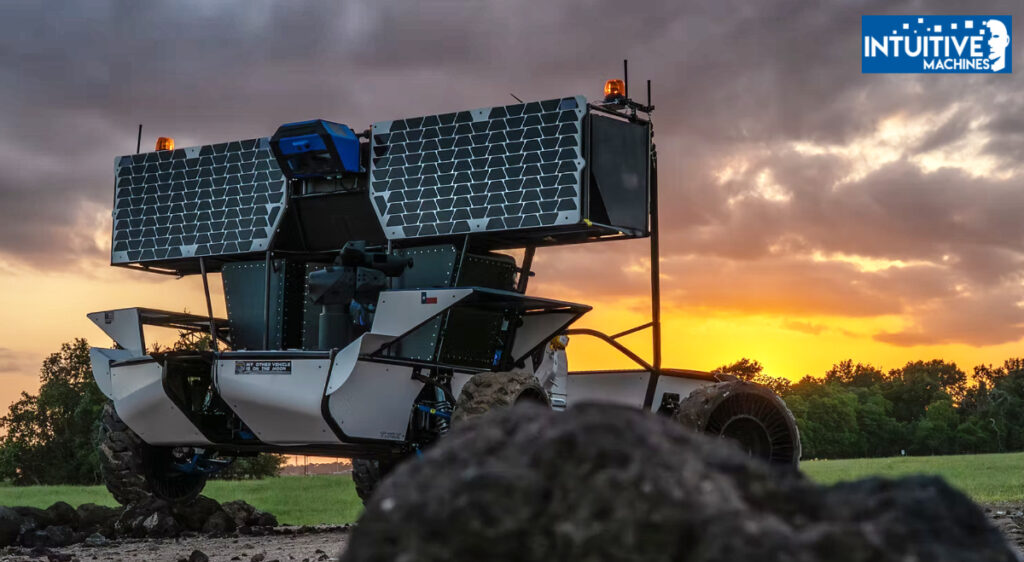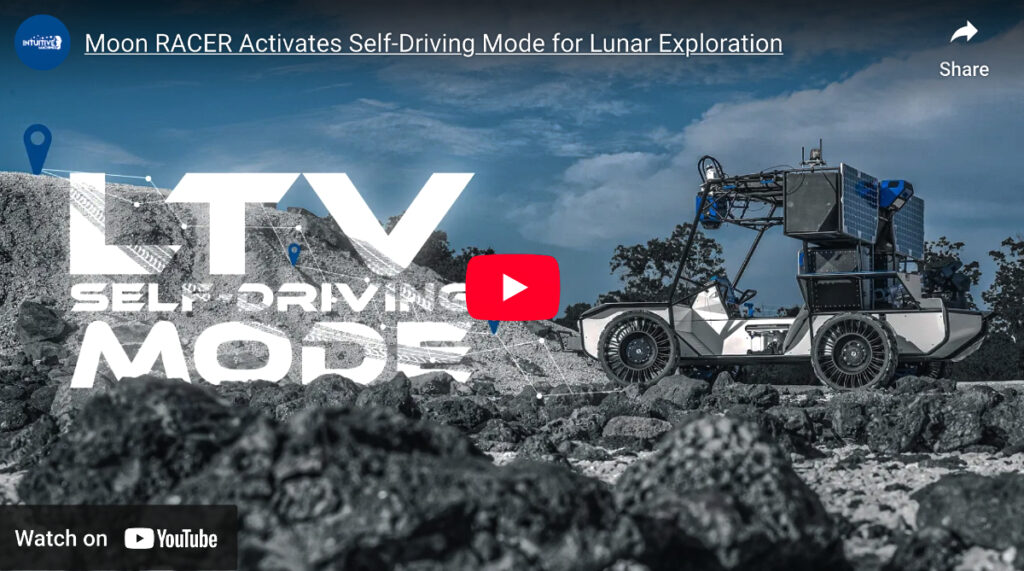
On a rugged, mock moonscape, the Moon RACER team (Intuitive Machines | Atlas Devices | AVL | Barrios | Boeing | CSIRO | FUGRO | Michelin | Northrop Grumman | Roush | University of Wisconsin-Madison | Michigan Technological University) demonstrated its terrestrial Lunar Terrain Vehicle mock-up’s ability to autonomously navigate using advanced LiDAR and perception software.
Just over a year since receiving NASA’s Lunar Terrain Vehicle Services feasibility assessment contract, the Intuitive Machines-led Moon RACER team has hit another milestone in its development timeline: successful integration and testing of its autonomous driving system.
The team successfully integrated a scanning LiDAR system into Moon RACER. This technology, short for Light Detection and Ranging, allows the lunar terrain vehicle to scan its surroundings by bouncing light off the terrain and capturing millions of data points.
These data points form what’s called a point cloud—a 3D map made entirely of dots. Each dot represents a specific point on the terrain, giving Moon RACER a way to “see” the environment around it in full detail. It’s similar to how bats use echolocation, but with light instead of sound.


CSIRO, Australia’s national science agency, and Moon RACER teammate, provided the autonomy software that uses the point cloud and vehicle sensor inputs to figure out the vehicle’s exact location and orientation, build a local map, spot potential hazards like rocks or slopes, and decide the safest way to drive. It’s the brain behind the eyes. CSIRO’s expertise is built on decades of developing navigation solutions for challenging terrain, GPS denied and extreme environments like underground mines.
To prove it works, the team tested its self-driving system at NASA Johnson Space Center’s Rock Yard, a simulated lunar terrain filled with boulders, craters, and loose soil. Moon RACER successfully navigated the environment on its own—no driver required.
Working toward NASA’s goal to have an operational lunar terrain vehicle on the Moon for ten years, Intuitive Machines believes this advancement is critical for the agency’s goal for sustained long-term human lunar exploration and autonomous commercial application when astronauts are not on the lunar surface.

In under a year, the Intuitive Machines-led Moon RACER team has transformed a concept into a driving reality—guided by expert feedback aimed to provide the best one-stop-shop solution for a LTV, surface delivery, and data transmission services. Since NASA selected the Intuitive Machines-led team for one of the LTV Services Feasibility Assessment contracts in April 2024, Intuitive Machines has:
- Completed a full-scale static mock-up and Crew Assessment Test & Safety Phase I with Apollo legends Charlie Duke and Harrison Schmitt, along with Shuttle-era and International Space Station astronauts in September 2024, giving Moon RACER the benefit of hard-won experience from humanity’s only lunar drivers.
- Conducted field testing on the terrestrial Moon Racer mock-up at Meteor Crater National Landmark in November 2024, simulating lunar terrain and stress-testing robotic systems.
- Completed NASA Human-in-the-Loop Testing at Johnson Space Center in December 2024, where astronauts in pressurized spacesuits evaluated the Moon RACER’s mock-up controls, displays, and safety features in mission-like conditions.
- Completed Crew Assessment Test & Safety Phase II—bringing the newly improved Moon RACER back before NASA astronauts, who may one day drive it on the lunar surface.
As previously announced, the LTVS feasibility assessment contract is still competitive, as the Intuitive Machines-led Moon RACER team is one of only three vendors vying for the next phase of the LTV contract, the delivery and demonstration mission, which NASA plans to award by the end of 2025.
There are long stretches when astronauts are not present on the Moon and we believe autonomous driving is key to continuous science research and commercial activity.” said Intuitive Machines LTV Lead Gary Spexarth. “This capability allows the vehicle to work for other customers to conduct surveys, transport cargo, scout terrain, and collect valuable data between Artemis missions, increasing the value of every lunar mission, even when no one is around.”

